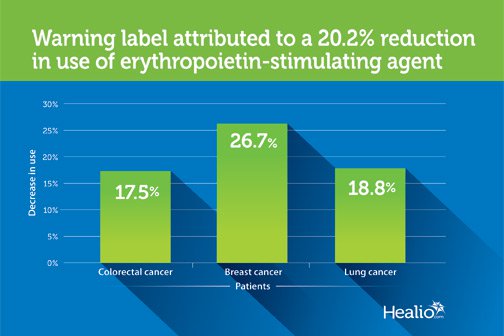FDA boxed warning reduces erythropoietin-stimulating agent use
A boxed warning advising of the risk for venous thromboembolism reduced use of erythropoietin-stimulating agents, study data showed.
“Before the passage of the 2007 U.S. FDA Amendments Act, boxed warnings were considered the strongest FDA mechanism for communicating drug safety concerns to the public,” John Bian, PhD, of the University of South Carolina College of Pharmacy and the Hollings Cancer Center, and colleagues wrote. “However, critics question the effectiveness of boxed warnings, contending that providers and patients may not actually receive or agree with safety concerns in the warnings and concerned that the FDA may not have adequate authority and resources for postwarning surveillance.”
The researchers used the SEER database to obtain data on 45,319 Medicare patients aged 66 years and older treated between 2004 and 2009. Bian and colleagues “exploited a natural experiment” and divided patients among an intervention group — including patients who had breast, colorectal or lung cancers who were undergoing therapy and targeted by the warning — or the control group, which included patients who had myelodysplastic syndromes and were not targeted by the warning. The researchers considered January 2004 to September 2006 to be the prewarning period, and April 2007 to September 2009 to be the postwarning period.
Erythropoietin-stimulating agent usage and hospitalization for VTE served as binary dependent variables.
The groups showed similar rates of erythropoietin-stimulating agent use before the warning, but use in the intervention group declined sharply after the warning was issued. Regression analysis showed a 20.2% reduction in the likelihood that erythropoietin-stimulating agents would be used on patients in the intervention group (P < .001). Researchers linked the warning with a 17.5% decrease of use in patients with colorectal cancer, a 26.7% decrease in patients with breast cancer and an 18.8% decrease for patients with lung cancer (P < .001 for all). However, the boxed warning did not significantly associate with the likelihood that patients would be hospitalized for VTE.
“This is the first study using a natural experiment to examine the effects of FDA boxed warnings on utilization and adverse outcomes,” the researchers wrote. “In an era of ever-faster FDA drug approvals, likely fueled by the 21st Century Cures Act and manifested by a growing number of boxed warnings, our study has filled a critical gap in evidence on effectiveness of one commonly used drug safety warning mechanism. Future studies should continue to investigate the impact of boxed warnings on serious adverse events and to examine other regulatory actions (such as the FDA REMS initiative) to promote the safe use of drugs whose effectiveness remains largely unknown.” – by Andy Polhamus
Disclosure: Bian reports no relevant financial disclosures. Please see the full study for a list of all other researchers’ relevant financial disclosures.

